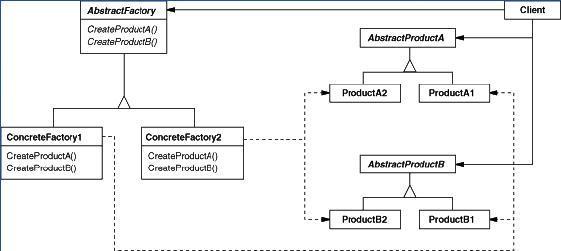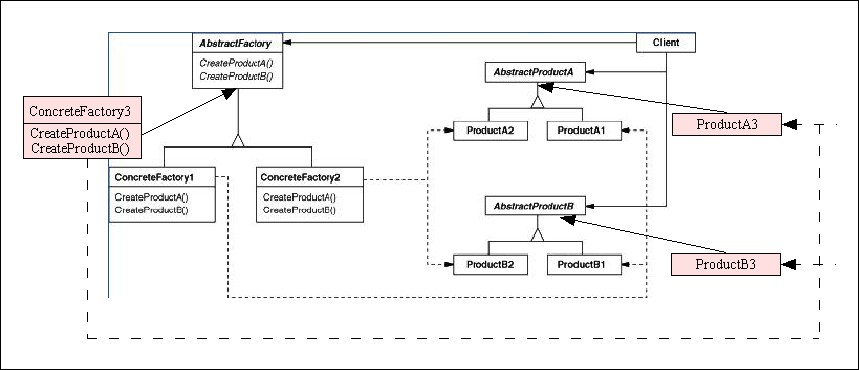設計模式的目的就是盡量減少“變化”對程序的影響,尤其是對客戶程序的影響。AbstractFactory模式作為創建型模式的一種,解決的就是“new”在變化中可能引起的問題。
先來看看new有何種不好,舉個創建汽車的車門的例子:
很自然的一種想法是:Door *door = new Door();
但是如果遇到創建老爺車的車門,創建現代車的車門,這段代碼就無所適從了。
OO為我們提供了哪些精華的思想?“封裝”,是的,將車門的創建封裝起來,于是我們有了靜態工廠方法:
客戶程序代碼:
1 Door* door = doorFactory->CreateDoor();
Door* door = doorFactory->CreateDoor();
庫程序代碼:
1 class DoorFactory
class DoorFactory
2

 {
{
3 public:
public:
4 Door* CreateDoor()
Door* CreateDoor()
5

 {
{
6 return new Door();
return new Door();
7 }
}
8 }
}
客戶程序在此是不會變化的,不管你是老爺車門,現代車門,還是鉆石車門,這些和客戶程序代碼都是沒關系的,究竟CreateDoor出來如何結果都交給多態來判斷,我們不用操心。
但是庫程序代碼還是需要更改的,但我們已經將“變化”與客戶程序隔離了。
需求又有變化了,不光要創建車門,還需要創建引擎,車燈,而且還是不同風格的。
這時候靜態工廠已經應付不來了,靜態工廠有其自身的缺陷“不能應對不同系列對象”的變化。
動機:
軟件系統中,經常面臨“一系列相互依賴的對象”的創建工作。(兩個特征:“一系列”,“相互依賴”)
將創建過程封裝起來,避免“客戶程序”和“多系列具體對象的創建工作”的緊耦合。
意圖:
提供一個接口,讓該接口負責創建一系列“相關或者相互依賴的對象”,無需指定他們具體的類。(GoF23)
思路:

對于客戶程序來說,只依賴于三個抽象的類:AbstractFactory,AbstractProductA,AbstractProductB。
以下是客戶程序代碼:
1 class CarManager
class CarManager
2

 {
{
3 protected:
protected:
4 AbstractFactory *abstractFactory;
AbstractFactory *abstractFactory;
5 public:
public:
6 //創造Car
//創造Car
7 void createCar(AbstractFactory *abstractFactory)
void createCar(AbstractFactory *abstractFactory)
8

 {
{
9 abstractFactory->CreateEngine();
abstractFactory->CreateEngine();
10 abstractFactory->CreateDoor();
abstractFactory->CreateDoor();
11 abstractFactory->CreateLight();
abstractFactory->CreateLight();
12 }
}
13 //其他的操作
//其他的操作

14
 void run()
void run() {}
{}
15 };
};
16
17 int _tmain(int argc, _TCHAR* argv[])
int _tmain(int argc, _TCHAR* argv[])
18

 {
{
19 CarManager *carManager = new CarManager();
CarManager *carManager = new CarManager();
20 //創建Classic風格的汽車
//創建Classic風格的汽車
21 carManager->createCar(new ClassicFactory());
carManager->createCar(new ClassicFactory());
22
23 return 0;
return 0;
24 }
}
所有關于創建的操作都是用抽象類完成的,對于具體是何種類型的對象由多態實現,以此來使“客戶代碼”和“多系列具體對象的創建工作”達到松耦合。
如果遇到還需要擴展其他風格的汽車,可以按下圖的思路

紅色的部分對應新風格的車輛,只需在庫程序中添加ConcreteFactory3,ProductA3,ProductB3三個類,而對于客戶代碼CarManager來說完全不受影響。
總結:
AbstractFactory模式有以下三個要點:
1.應對的問題是“多風格的系列對象創建”的變化問題,“系列對象”指的是這些對象之間有相互依賴或者相互作用的關系。否則使用“靜態工廠”足以。
2.抽象工廠和靜態工廠的核心是“封裝”,將對象的創建進行封裝,避免“new”引起的問題
3.抽象工程的另一個核心是“多態”,通過動態綁定來處理“不同風格”的問題
注:
AbstractFactory模式主要針對“風格”的變化,如果“對象”本身經常變化,那么該模式并不適用。
自己做的示例代碼,僅供參考
1
 /**/////////////////////////////////////////////////////////////////////////// 2
/**/////////////////////////////////////////////////////////////////////////// 2 // AbstractFactoryTest for AbstractFactory Pattern Test
// AbstractFactoryTest for AbstractFactory Pattern Test
3 //
//
4
 /**/////////////////////////////////////////////////////////////////////////// 5
/**/////////////////////////////////////////////////////////////////////////// 5
6 #include "stdafx.h"
#include "stdafx.h"
7 #include "iostream"
#include "iostream"
8 using namespace std;
using namespace std;
9
10 //Engine,Door,Light are the Abstract Product
//Engine,Door,Light are the Abstract Product
11 //這三個類對應UML圖中的AbstractProduct類
//這三個類對應UML圖中的AbstractProduct類
12 class Engine
class Engine
13

 {
{
14 public:
public:
15 Engine()
Engine()
16

 {
{
17 cout<<"Abstract Engine Create"<<endl;
cout<<"Abstract Engine Create"<<endl;
18 }
}
19 virtual void doSomething() = 0;
virtual void doSomething() = 0;
20 };
};
21
22 class Door
class Door
23

 {
{
24 public:
public:
25 Door()
Door()
26

 {
{
27 cout<<"Abstract Door Create"<<endl;
cout<<"Abstract Door Create"<<endl;
28 }
}
29 virtual void doSomething() = 0;
virtual void doSomething() = 0;
30 };
};
31
32 class Light
class Light
33

 {
{
34 public:
public:
35 Light()
Light()
36

 {
{
37 cout<<"Abstract Light Create"<<endl;
cout<<"Abstract Light Create"<<endl;
38 }
}
39 virtual void doSomething() = 0;
virtual void doSomething() = 0;
40 };
};
41
42 //Abstract Factory
//Abstract Factory
43 class AbstractFactory
class AbstractFactory
44

 {
{
45 public:
public:
46 AbstractFactory()
AbstractFactory()
47

 {
{
48 cout<<"AbstractFactory Create"<<endl;
cout<<"AbstractFactory Create"<<endl;
49 }
}
50 virtual Engine* CreateEngine() = 0;
virtual Engine* CreateEngine() = 0;
51 virtual Door* CreateDoor() = 0;
virtual Door* CreateDoor() = 0;
52 virtual Light* CreateLight() = 0;
virtual Light* CreateLight() = 0;
53 };
};
54
55 //SpeedEngine,SpeedDoor,SpeedLight are the Products of Speed Style
//SpeedEngine,SpeedDoor,SpeedLight are the Products of Speed Style
56 //這三個類對應UML圖中的ProductA1,ProductB1,ProductC1類
//這三個類對應UML圖中的ProductA1,ProductB1,ProductC1類
57 class SpeedEngine:public Engine
class SpeedEngine:public Engine
58

 {
{
59 public :
public :
60 SpeedEngine()
SpeedEngine()
61

 {
{
62 cout<<"Speed Engine Create"<<endl;
cout<<"Speed Engine Create"<<endl;
63 }
}
64
 void doSomething()
void doSomething() { }
{ }
65 };
};
66
67 class SpeedDoor:public Door
class SpeedDoor:public Door
68

 {
{
69 public :
public :
70 SpeedDoor()
SpeedDoor()
71

 {
{
72 cout<<"Speed Door Create"<<endl;
cout<<"Speed Door Create"<<endl;
73 }
}
74
 void doSomething()
void doSomething() { }
{ }
75 };
};
76
77 class SpeedLight:public Light
class SpeedLight:public Light
78

 {
{
79 public :
public :
80 SpeedLight()
SpeedLight()
81

 {
{
82 cout<<"Speed Light Create"<<endl;
cout<<"Speed Light Create"<<endl;
83 }
}
84
 void doSomething()
void doSomething() { }
{ }
85 };
};
86
87 //classicEngine,classicDoor,classicLight are the products of Classic style
//classicEngine,classicDoor,classicLight are the products of Classic style
88 //這三個類對應UML圖中的ProductA2,ProductB2,ProductC2類
//這三個類對應UML圖中的ProductA2,ProductB2,ProductC2類
89 class ClassicEngine:public Engine
class ClassicEngine:public Engine
90

 {
{
91 public :
public :
92 ClassicEngine()
ClassicEngine()
93

 {
{
94 cout<<"Classic Engine Create"<<endl;
cout<<"Classic Engine Create"<<endl;
95 }
}
96
 void doSomething()
void doSomething() { }
{ }
97 };
};
98
99 class ClassicDoor:public Door
class ClassicDoor:public Door
100

 {
{
101 public :
public :
102 ClassicDoor()
ClassicDoor()
103

 {
{
104 cout<<"Classic Door Create"<<endl;
cout<<"Classic Door Create"<<endl;
105 }
}
106
 void doSomething()
void doSomething() { }
{ }
107 };
};
108
109 class ClassicLight:public Light
class ClassicLight:public Light
110

 {
{
111 public :
public :
112 ClassicLight()
ClassicLight()
113

 {
{
114 cout<<"Classic Light Create"<<endl;
cout<<"Classic Light Create"<<endl;
115 }
}
116
 void doSomething()
void doSomething() { }
{ }
117 };
};
118
119 //Factory for Speed Cars
//Factory for Speed Cars
120 //對應UML圖中的ConcreteFactory1類
//對應UML圖中的ConcreteFactory1類
121 class SpeedFactory:public AbstractFactory
class SpeedFactory:public AbstractFactory
122

 {
{
123 public:
public:
124 SpeedFactory()
SpeedFactory()
125

 {
{
126 cout<<"SpeedFactory Create"<<endl;
cout<<"SpeedFactory Create"<<endl;
127 }
}
128 virtual Engine* CreateEngine()
virtual Engine* CreateEngine()
129

 {
{
130 return new SpeedEngine();
return new SpeedEngine();
131 }
}
132 virtual Door* CreateDoor()
virtual Door* CreateDoor()
133

 {
{
134 return new SpeedDoor();
return new SpeedDoor();
135 }
}
136 virtual Light* CreateLight()
virtual Light* CreateLight()
137

 {
{
138 return new SpeedLight();
return new SpeedLight();
139 }
}
140 };
};
141
142 //Factory for classic Cars
//Factory for classic Cars
143 //對應UML圖中的ConcreteFactory2類
//對應UML圖中的ConcreteFactory2類
144 class ClassicFactory:public AbstractFactory
class ClassicFactory:public AbstractFactory
145

 {
{
146 public:
public:
147 ClassicFactory()
ClassicFactory()
148

 {
{
149 cout<<"ClassicFactory Create"<<endl;
cout<<"ClassicFactory Create"<<endl;
150 }
}
151 virtual Engine* CreateEngine()
virtual Engine* CreateEngine()
152

 {
{
153 return new ClassicEngine();
return new ClassicEngine();
154 }
}
155 virtual Door* CreateDoor()
virtual Door* CreateDoor()
156

 {
{
157 return new ClassicDoor();
return new ClassicDoor();
158 }
}
159 virtual Light* CreateLight()
virtual Light* CreateLight()
160

 {
{
161 return new ClassicLight();
return new ClassicLight();
162 }
}
163 };
};
164
165 //Client Code ---- use the Abstract Factory & Abstract Product to create the car
//Client Code ---- use the Abstract Factory & Abstract Product to create the car
166 //this is never changed
//this is never changed
167 class CarManager
class CarManager
168

 {
{
169 protected:
protected:
170 AbstractFactory *abstractFactory;
AbstractFactory *abstractFactory;
171 public:
public:
172 //創造Car
//創造Car
173 void createCar(AbstractFactory *abstractFactory)
void createCar(AbstractFactory *abstractFactory)
174

 {
{
175 abstractFactory->CreateEngine();
abstractFactory->CreateEngine();
176 abstractFactory->CreateDoor();
abstractFactory->CreateDoor();
177 abstractFactory->CreateLight();
abstractFactory->CreateLight();
178 }
}
179 //其他的操作
//其他的操作

180
 void run()
void run() {}
{}
181 };
};
182
183 int _tmain(int argc, _TCHAR* argv[])
int _tmain(int argc, _TCHAR* argv[])
184

 {
{
185 CarManager *carManager = new CarManager();
CarManager *carManager = new CarManager();
186 //創建Classic風格的汽車
//創建Classic風格的汽車
187 carManager->createCar(new ClassicFactory());
carManager->createCar(new ClassicFactory());
188
189 return 0;
return 0;
190 }
}